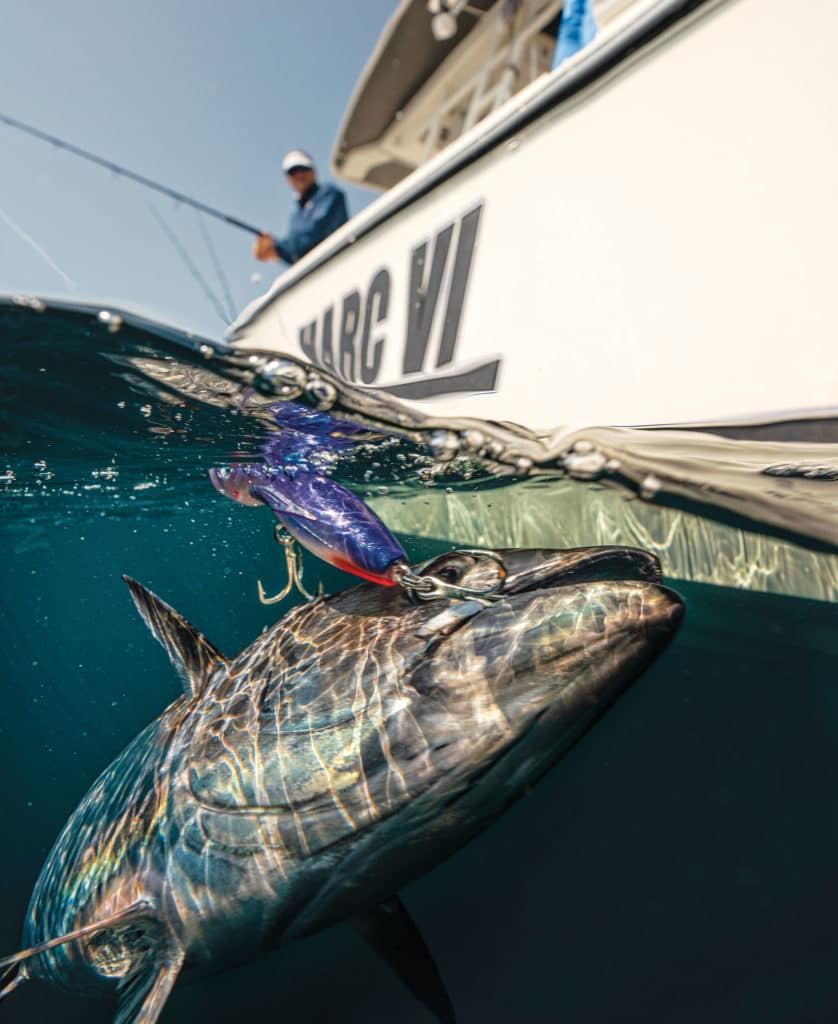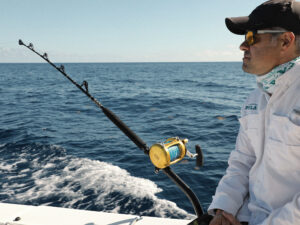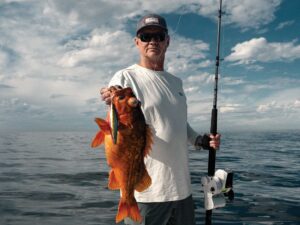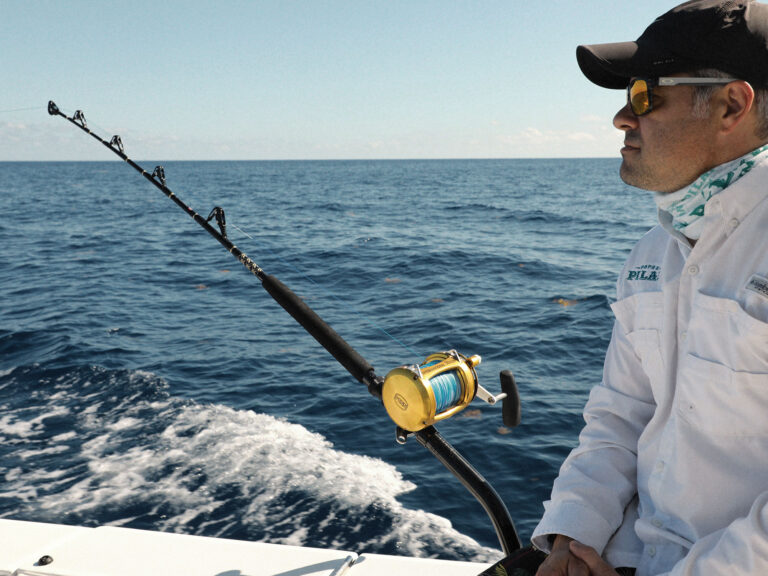
Early starts are relative, based on geography. For example, clearing a dark South Florida inlet at 5 a.m. is extremely aggressive, whereas off the Northeast, you’d be arriving late to the party—and likely leaving without so much as a parting gift.
When Capt. Cory Crochetiere said to meet at Rhode Island’s Avondale Boat Yard at 2:30 a.m. to prep for a 3 a.m. departure, my initial thought was, Why bother sleeping? Our goal was to be at a 25-fathom hole along a 15- to 20-fathom contour line prior to first light, well before the fleets of tuna seekers. I had MARC VI up there to film a TV show episode on jig-and-pop bluefin tuna, and Crochetiere would be leading the way. He explained that, if things went as planned, I’d become a card-carrying member of the coveted “Pancake House.” More on this later.
A renowned jig-and-pop expert guiding out of Westport, Connecticut, Crochetiere trailers his 23-foot SeaCraft to Long Island, eastern Connecticut, Rhode Island, and even Cape Cod in pursuit of tuna. We fished together in late July for 30- to 40-pound bluefins, running as close as 25 miles off Watch Hill. “Our bluefin bite starts to heat up during the first half of June and really gets going in July,” Crochetiere says. “The bite lasts into October some years. By comparison, our yellowfin bite doesn’t get consistent until mid- to late July, and it usually spans through September.”
Northeast Tunas Eat Sand Eels
According to Crochetiere, the bluefin bite is 99 percent based on sand-eel populations; find the heaviest concentrations and the bluefins should abound. “This can occur anywhere from 10 to 70 miles offshore,” he claims. “Our inshore yellowfins inhabit the same areas and also feed on sand eels.” He seeks bottom irregularities along contour lines between 20 and 40 fathoms, highlighted by sharp water-surface-temperature breaks and strong chlorophyll indicators, the latter of which gathers baitfish.

Whales and Porpoises Often Feed Near Tuna
Upon reaching our destination, we established a drift. In total darkness, we studied my Simrad screens for sand eels and bluefins. Upon the first hint of soft light, a whale abruptly surfaced close to the boat. Then a dozen or so porpoises charged our way. Soon more whales surfaced and more porpoises arrived, even molas (ocean sunfish) made the scene, and all were aggressively hunting and feeding. Suddenly, it seemed like we were floating in an aquarium. Crochetiere pointed out bluefins on the fish finder and said, “Start jigging!”

Jigging for Yellowfin and Bluefin Tuna
Given it was still soft light, we focused on jigging for tuna. I brought along Penn 4500 and 5500 spinning reels loaded with 20- and 30-pound braid, and 40- and 50-pound fluorocarbon leaders, and Penn two-speed Torque 15 reels filled with 30-pound braid and 50-pound fluorocarbon leaders; heavier spinning outfits were on hand, should larger bluefins appear. Our irons consisted of Williamson’s Koika and Kensaki jigs.
“Jigging methods vary greatly from one angler to another,” Crochetiere explains. “But my go-to technique consists of pauses and jigging-speed increases. Oftentimes, the pause followed by an acceleration in jigging speed triggers a bite.”

Tuna Fishing Tackle
Crochetiere defines “light tackle” as a reel capable of holding 300 yards of 50- to 65-pound hollow-core or braided line and a 50- to 60-pound fluorocarbon leader. For him, a “heavy” setup will carry the same types of lines in 80- to 100-pound-test, matched with 80- to 100-pound leader. For joining line to leader, he prefers a 20-turn FG knot, with a second FG knot of 12 to 15 turns on top of that one. The same holds true for pitching chuggers.
Catching Your Tuna Limit Early in the Morning
As anticipated, Crochetiere and I boated our allotted two bluefins per vessel per day by 5:30 a.m. (school fish from 27 to less than 47 inches). Anglers limiting out as early as we did boast about the “Pancake House” via VHF and satphone texts. The dig refers to the fact that they can return to land in time to join other successful tuna anglers and friends for pancakes at a local breakfast joint. I opted for an honorary membership in this semi-fictitious club, preferring to remain offshore to catch and release more fish.
Topwater Tuna Fishing
We pursued bluefins primarily with jigs because they remained deep. But Crochetiere predicted our best popping opportunities would occur around midday, when bluefins occasionally rise to the surface. Sure enough, that’s when our sonar showed fish within 10 feet of the surface, and I began pitching a Rapala X-Rap Magnum Xplode, model 130. The blowups behind the chugger were breathtaking, surpassed only by the thrill of the actual hookups.

For topwater poppers, Crochetiere suggests casting as far as you can, then taking up slack before imparting a few short, aggressive pops, with one- to two-second intervals between the pops. “I often do two or three pops and then a pause,” he says. “Frequently, they’ll crush the lure on the pause.” He and I scored eight bluefins that day, two hooked on topwater poppers.

New Jersey Tuna Fishing
Jig-and-pop is also the craze off New Jersey. Ryan DeGraw considers it his favorite way to take both bluefins and yellowfins. Pretty much mirroring that midsummer to early-fall peak for consistency, he also plays his hand early once he learns of tunas migrating off his home port of Manasquan.
“As long as they’re here, you can do this,” DeGraw says. “We usually hear reports of tuna around mid-May. The challenge then is that they’re scattered and not committed to their honey holes. But you can catch them on the jig-and-pop with some hard searching. Our bluefins get pretty decent around mid-June, and yellowfin tuna begin settling in early to mid-July.”
Sand eels dictate the fishery, and bird-dogging mammals is a big part of the game, as is focusing on specific bottom contours and water-surface-temperature gradients; pretty much the same drill as throughout the Northeast.
Oil Slicks at the Surface Signal Tuna Feeding
When he wants to jig for yellowfins, DeGraw also looks for slicks and birds. “Tuna chicks over oil-like slicks always warrant a drift. The slicks are from feeding fish, so the yellowfins should be nearby,” he says.
“We explore these slicks by splitting the effort, having two anglers cast poppers and two anglers jig until we figure out where the fish are holding and their preference.
“As far as prime conditions, I love calm water for topwater popping; fish see the poppers better. In rough water, they’ll sometimes strike at it three or four times because they can’t see it as well. On the other hand, I like jigging when it’s a bit choppy, like in 2- to 4-footers.”
Chumming for Yellowfin Tuna
Live-chumming with peanut bunker gets the yellowfins up and feeding aggressively. Once attracted, the chumming stokes up prime popping opportunities. “Sometimes, poppers outclass the liveys,” DeGraw says.

“Recently, we live-chummed up the yellowfins, but they were reluctant to eat our pinned baits. However, we ended up catching the first six or so yellowfins on poppers before they finally warmed up to our live baits.”
How-To Jig for Tuna
For jigging, DeGraw prefers to drop his iron to the bottom and work it back. “A lot depends on the marks on the sonar,” he says. “For yellowfins, I like a fast retrieve with aggressive, short pumps. For bluefins, I enjoy success by snap-jigging—ripping the jig straight up and letting it fall a little prior to taking up the slack from a broad rod sweep.”
When targeting yellowfins with poppers, DeGraw aggressively pops the lure, waits a few seconds for the bubble trail to clear, and repeats the tactic. “By comparison, bluefins seem to react better to longer pauses approaching 10 seconds or so,” he says. “They don’t appear to want to chase down a topwater as aggressively as yellowfins.”
Read Next: Tuna Fishing with Topwater Lures
When Jigs and Topwaters Are Better Than Trolling
When asked why he’s addicted to jig-and-pop tuna fishing, DeGraw sums it up perfectly: “Besides the fact that it is a lot more fun than trolling or bait-fishing, there are numerous situations where these tactics prove more effective. Whether it’s for more accurately matching what the fish are feeding on, or when they become finicky and spooked by boats trolling entire spreads, jigging and popping flat out puts tuna in the boat.”

Recent Bluefin Size Classes
“Every year is different, but oftentimes the same year-class of bluefins returns year after year, they just get larger each season,” Crochetiere says. “In 2019, we had two separate year-classes: fish measuring from the mid-20 inches to the low 30s, and from 50 to the low 60s. In 2020, we had the same year-classes return, but the younger tuna had reached the mid-30s, and the older ranged from 60 to 70 inches. Another year-class of 20-inchers and high 30- to low 40-inchers joined the mix in 2021. This was in addition to some large 65- to 80-inch bluefins, and giants measuring 95 to 115. I do not specifically target the giants on jig-and-pop tackle, but they are occasionally hooked on such gear. And that usually ends in the fish’s favor,” Crochetiere says.









